Fortigate Only Restrict Admin Logins for Wan Interface Updated FREE
Fortigate Only Restrict Admin Logins for Wan Interface
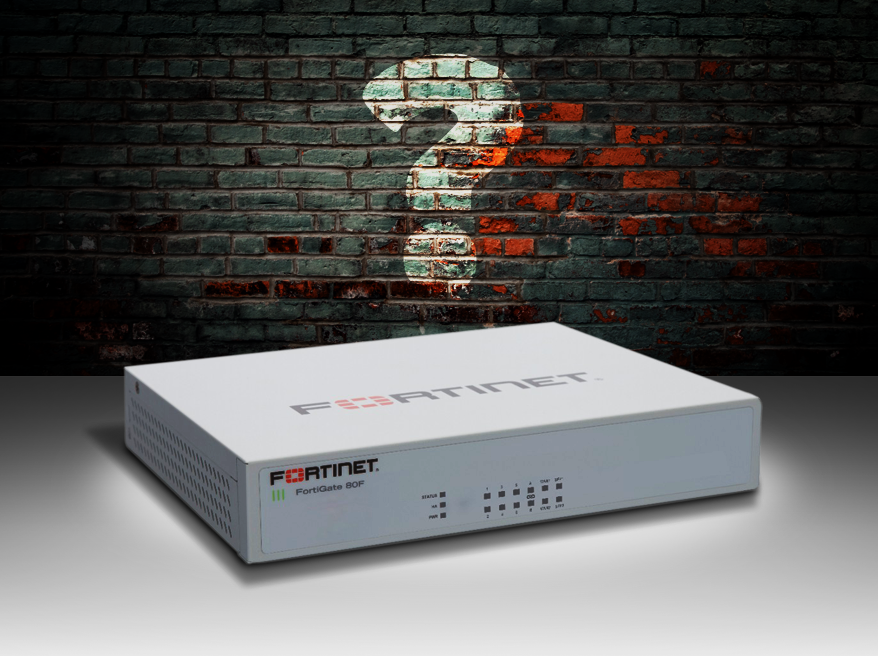
We are going to try to provide a elementary step-by-stride on how to brand your shiny, new, just-out-of-the-box FortiGate firewall practise firewall things like it's supposed to. This is not a super-brusk process, only it isn't circuitous, either (with cheers to our cracking partner, Fortinet!).
BUT, it should be noted that most of the FortiGate desktop models have a default configuration that includes a DHCP server on the LAN (or internal) interface and a security policy that securely allows all sessions from the internal network to reach the Net. Because of this, yous can connect your desktop FortiGate to the Cyberspace in two unproblematic steps:
(Oh, by the style #i:) In order to use this installation method, your Isp must provide connectivity with DHCP without authentication. You must also use IPv4 to connect your FortiGate to the Internet.)
Hither'south how you practice it:
First, connect the WAN interface on your FortiGate (that'southward the holes on the front end of the firewall) to your ISP-supplied equipment (that'southward your router), and connect the internal network (like your home computer) to the default LAN interface on your FortiGate. Turn on the ISP's equipment, the FortiGate, and the computers on the internal network.
Second, for computers on the internal network:
Windows Vista/7/viii/10 users:
• In Network and Sharing Centre, select Modify Adapter Settings.
• Open up the Local Surface area Connection (Ethernet or WiFi) and select Properties.
• Select Internet Protocol Version 4 (TCP/IPv4) and then select Properties.
• Select Obtain an IP Accost Automatically and Obtain DNS Server Address Automatically.
• Click OK.
Mac Os X users:
• Go to Organization Preferences > Network and select your Ethernet connection.
• Set Configure IPv4 to Using DHCP.
Results
To confirm successful Internet connectivity from whatever computer on the internal network, open a web browser and browse to whatsoever website.
Now then, for the rest of you, nosotros have:
Installing a FortiGate in NAT mode
For our purposes, nosotros'll connect / configure a new FortiGate in NAT fashion. It's the most common method. This will securely connect a private network to the Internet.
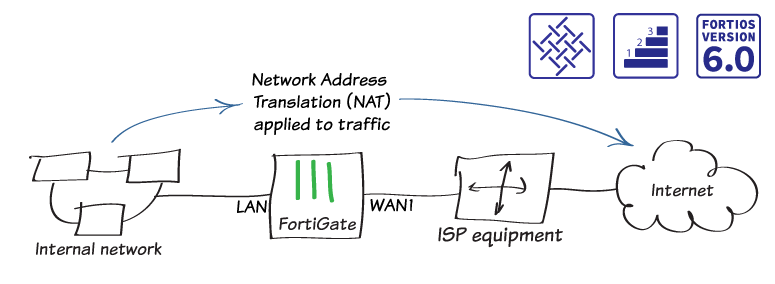
Basically, in NAT way, you install a FortiGate every bit a gateway, or router, betwixt two networks. Usually, this will be between a individual network and the Internet. This allows the FortiGate to hide the IP addresses of the private network using NAT. (In case you lot're wondering, By the way, Network Address Translation (NAT) is the ability of a router to translate a public IP accost to a private IP address and vice versa. It adds security to the network by keeping the individual IP addresses hidden from the outside world.)
Connecting network devices
• Connect the FortiGate to your Isp-supplied equipment using the Internet-facing interface. This is typically WAN or WAN1, depending on your model.
• Connect a PC to the FortiGate, using an internal port (in the example, port 3).

• Power on the Internet service provider equipment, the FortiGate, and the PC on the internal network.
• Use the PC to connect to the FortiGate GUI using either FortiExplorer or an Cyberspace browser. For more information near connecting to the GUI, see the QuickStart Guide for you FortiGate model.
• Log in using an admin business relationship. The default admin account has the username admin and no countersign.
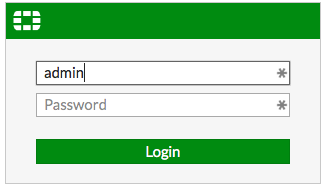
Configuring interfaces
• To edit the Internet-facing interface (in the example, wan1), go to Network > Interfaces.
• Prepare the Estimated Bandwidth for the interface based on your Cyberspace connexion.
• Set Role to WAN.
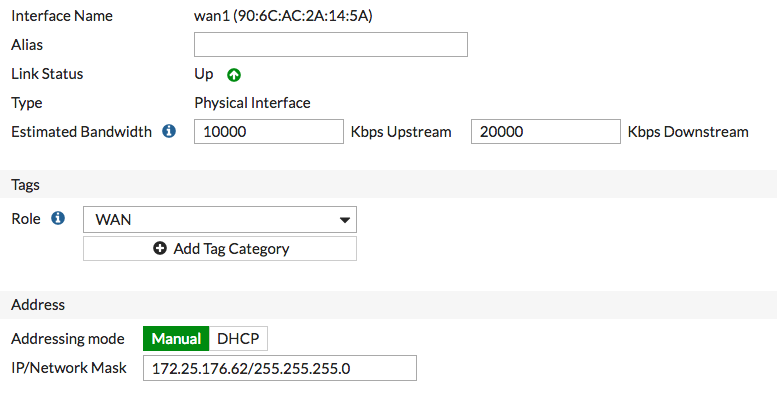
• To make up one's mind which Addressing mode to employ, check if your Internet access provider provides an IP address for you to use or if the ISP equipment uses DHCP to assign IP addresses.
– If your ISP provides an IP address, ready Addressing mode to Transmission and set up the IP/Network Mask to that IP address.
– If your ISP equipment uses DHCP, set Addressing way to DHCP to allow the equipment to assign an IP address to WAN1.
• Edit the LAN interface, which is called Internal on some FortiGate models.
(Oh, by the way #two: If your FortiGate doesn't have a default LAN interface, for this step, you tin use either an individual interface or create a software switch to combine the divide interfaces into a single virtual interface.)
• Set Function to LAN.
• Set Addressing mode to Manual and gear up the IP/Network Mask to the individual IP address that you desire to utilise for the FortiGate.
• If you need to assign IP addresses to devices on your internal network, enable DHCP Server.
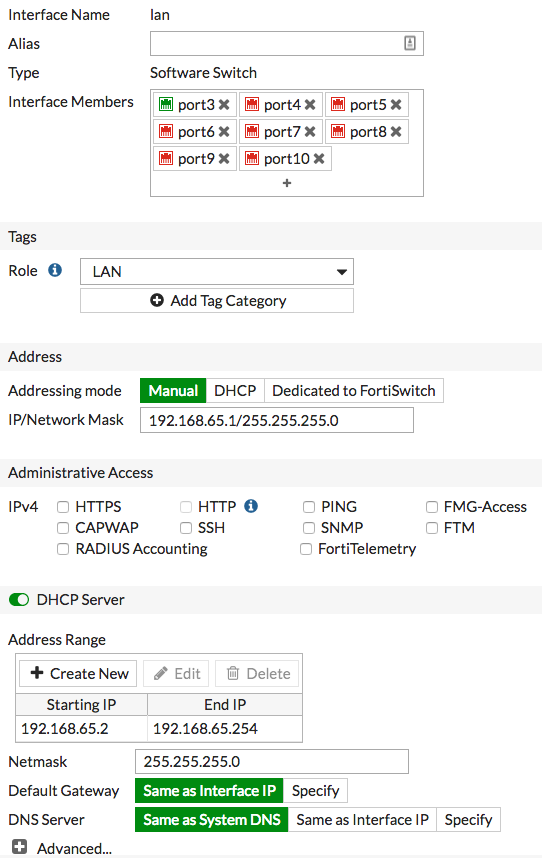
Adding a default road
• To create a new default route, become to Network > Static Routes. Typically, you have only one default route. If the static route listing already contains a default route, you tin edit it, or delete the route and add a new one.
• Set up Destination to Subnet and leave the destination IP address fix to 0.0.0.0/0.0.0.0.
• Set Gateway to the IP address provided by your ISP and Interface to the Net-facing interface.
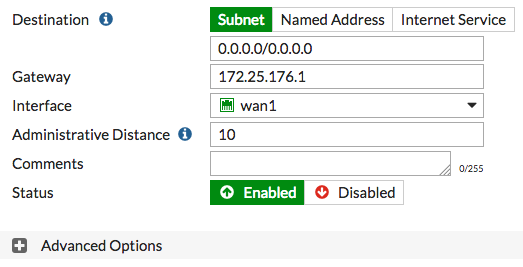
Selecting DNS servers (optional)
The FortiGate DNS settings are configured to use FortiGuard DNS servers by default, which is sufficient for about networks. If you need to alter the DNS servers, get to Network > DNS, select Specify, and add together Primary and Secondary servers.

Creating a policy
(Oh, by the way #3: Some FortiGate models include an IPv4 security policy in the default configuration. If you have one of these models, edit information technology to include the logging options shown below, and then proceed to the results section.)
• To create a new policy, become to Policy & Objects > IPv4 Policy.
• Give the policy a Proper name that indicates that the policy will be for traffic to the Internet (in the example, Internet).
• Set the Incoming Interface to lan and the Approachable Interface to wan1. Set Source, Destination Address, Schedule, and Services as required.
• Ensure the Action is set to Have.
• Plough on NAT and select Use Outgoing Interface Address.
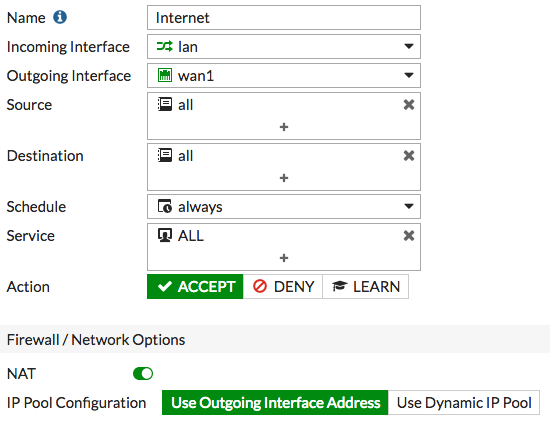
• Roll downwardly to view the Logging Options. To view the results later, enable Log Allowed Traffic and select All Sessions.

Results
• Scan the Internet using the PC on the internal network.
• If you can't connect to the Internet, see FortiGate installation troubleshooting.
• To view information virtually FortiGate traffic, become to FortiView > Traffic from LAN/DMZ > Sources. The PC appears on the list of sources.

• To view more detailed information about the traffic from the PC, right-click the entry for the PC and select Drill Down to Details.
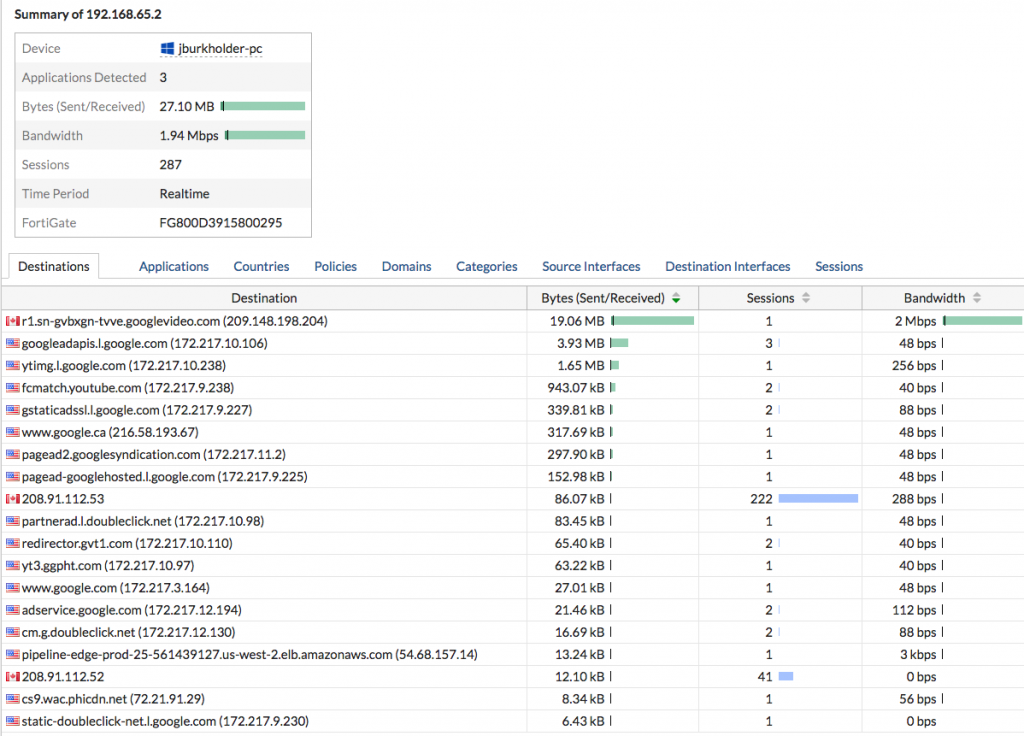
• If your FortiGate model has internal storage and disk logging enabled, a drop-down menu in the meridian corner allows yous to view historical logging information for the previous five minutes, 1 hour, and 24 hours.
• If you're not sure whether your model supports disk logging, download the FortiGate Characteristic/Platform Matrix hither.
And, for farther stimulating reading, you can check out NAT mode installation here.
So that should be just plenty to get yous into real trouble, then nosotros'll phone call it a day. If you accept ANY questions almost this or anything else Fortinet related, we would love to hear from yous, so just electronic mail us or phone call Corporate Armor at 877-449-0458. And thanks for reading!
Learn more!
Consider protecting your network with APC Uninterrupted Power Systems
The cyber-implications of the Ukraine War for the residue of us
Russia rattles its' Cyber-Saber: What could they practice to united states of america?
Fortigate Only Restrict Admin Logins for Wan Interface
DOWNLOAD HERE
Source: https://www.corporatearmor.com/fortigate/how-do-i-set-up-my-fortinet-fortigate-firewall/
Posted by: ulyssesguithay88.blogspot.com



Comments
Post a Comment